Part 1: Mass of the Catechumens
Because the Offertory is the most different from the Novus Ordo of any large portion of the Mass, all of the prayers are included here to highlight those texts which may be the most unfamiliar. The Roman Canon is also presented in its entirety to show how much of it is already familiar due to its use in the Ordinary Form, where it is also called "Eucharistic Prayer 1."
Because the Offertory is the most different from the Novus Ordo of any large portion of the Mass, all of the prayers are included here to highlight those texts which may be the most unfamiliar. The Roman Canon is also presented in its entirety to show how much of it is already familiar due to its use in the Ordinary Form, where it is also called "Eucharistic Prayer 1."
Where possible, the translations given are the exact equivalent currently used in the Novus Ordo. This choice was made in order to provide a translation that may be more familiar than the one that is found in Latin hand missals, and to highlight how much of the Latin Mass is already familiar to many Catholics. The translations in the 2011 revision of the Roman Missal are very faithful to the Latin, with a few minor adjustments made for syntax in the English.
Note that even in places where the translated text is the same across Forms, the rubrics (priest's actions) are significantly altered and reduced in the Ordinary Form.
Many prayers in this part of the Mass are said in secret (in a low voice or silently) and much of it happens quickly, so most of the Latin texts are not given here. A full side-by-side of the Latin texts of the Mass and their translations can be found here.
THE OFFERTORY
The priest recites the Offertory, the next Proper of the day, which is a verse taken from Scripture or a prayer composed by the Church.
Until this point, the chalice, paten, and pall have been covered by the chalice veil. He removes the chalice veil and pall and picks up the paten with the host on it.
Receive, O holy Father, almighty and eternal God, this spotless host which I, Your unworthy servant, offer unto You, my living and true God, for my own countless sins, offenses, and negligences, and for all here present.
As also for all faithful Christians living and dead, that it may avail both for my own and their salvation unto life eternal. Amen.
He makes the Sign of the Cross with the paten and tilts it so that the host slides onto the corporal.
He takes the chalice to the Epistle side of the altar and pours wine and water into it. The wine represents the divine Nature of Jesus and the water represents human nature, both of which coexisted in the Person of Christ. It also points to His Passion, in which blood and water flowed from His Side.
Only the water, representing humanity, is blessed before it is poured into the chalice. The wine represents Christ and therefore needs no blessing.
O God, Who in a wonderful manner created and enobled human nature and still more wonderfully renewed it, grant that, by the mystery of this water and wine, we may be made partakers of His divinity Who vouchsafed to become partaker of our humanity, Jesus Christ Your Son, Our Lord, Who lives and reigns with You in the unity of the Holy Ghost, One God, world without end. Amen.
He returns to the center of the altar and offers the chalice.
We offer unto You, O Lord, the chalice of salvation, beseeching Your clemency, that it may ascend in the sight of Your divine majesty with a sweet savor, for our own salvation and for that of the whole world. Amen.
Bowing with hands joined on the altar:
In the spirit of humility and with a contrite heart, receive us O Lord and grant that the sacrifice which we offer this day in Your sight may be pleasing to You, O Lord God.
He stands upright and makes the Sign of the Cross over the host and chalice:
Come, O Sanctifier, almighty and eternal God, and bless this sacrifice prepared for Your holy Name.
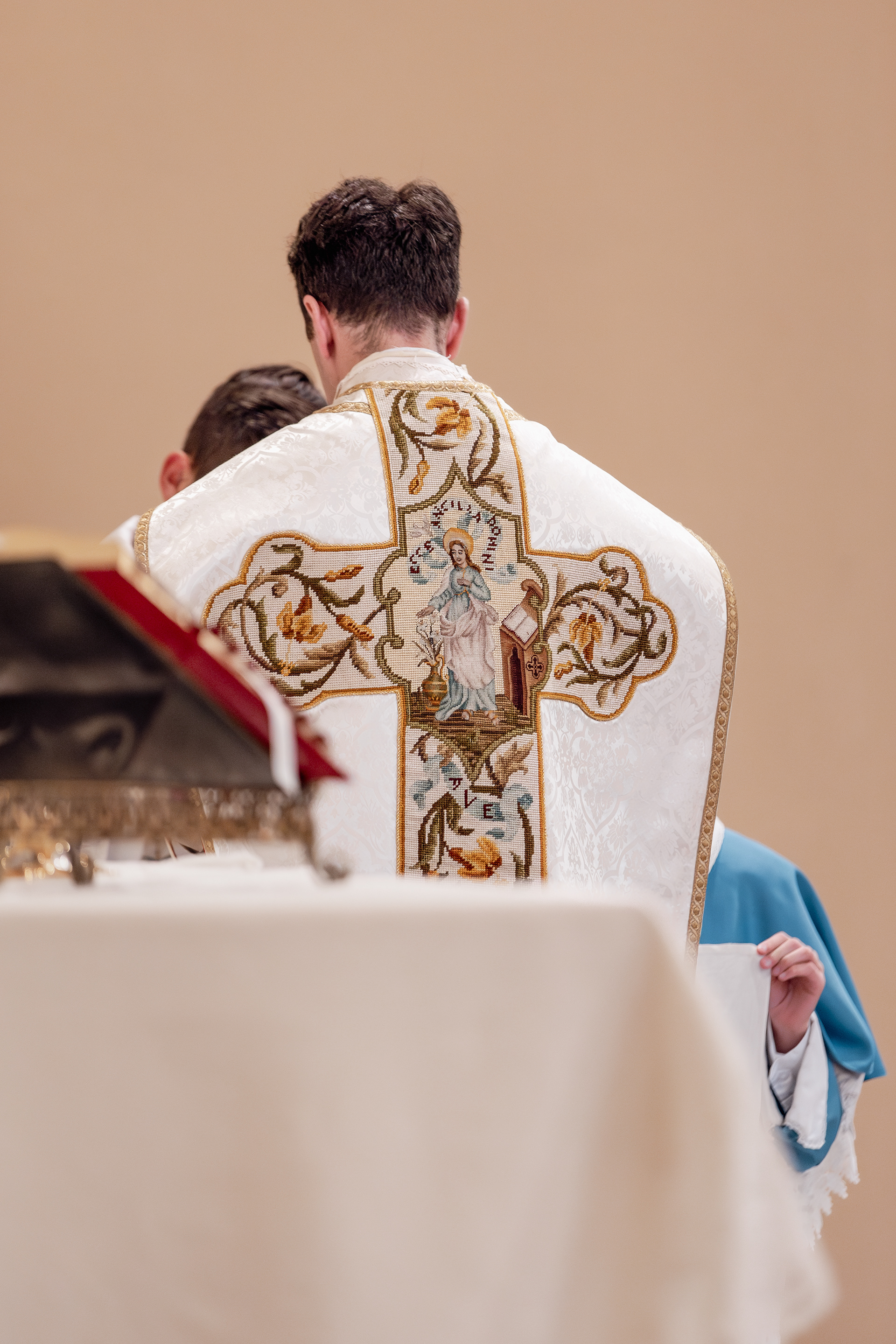
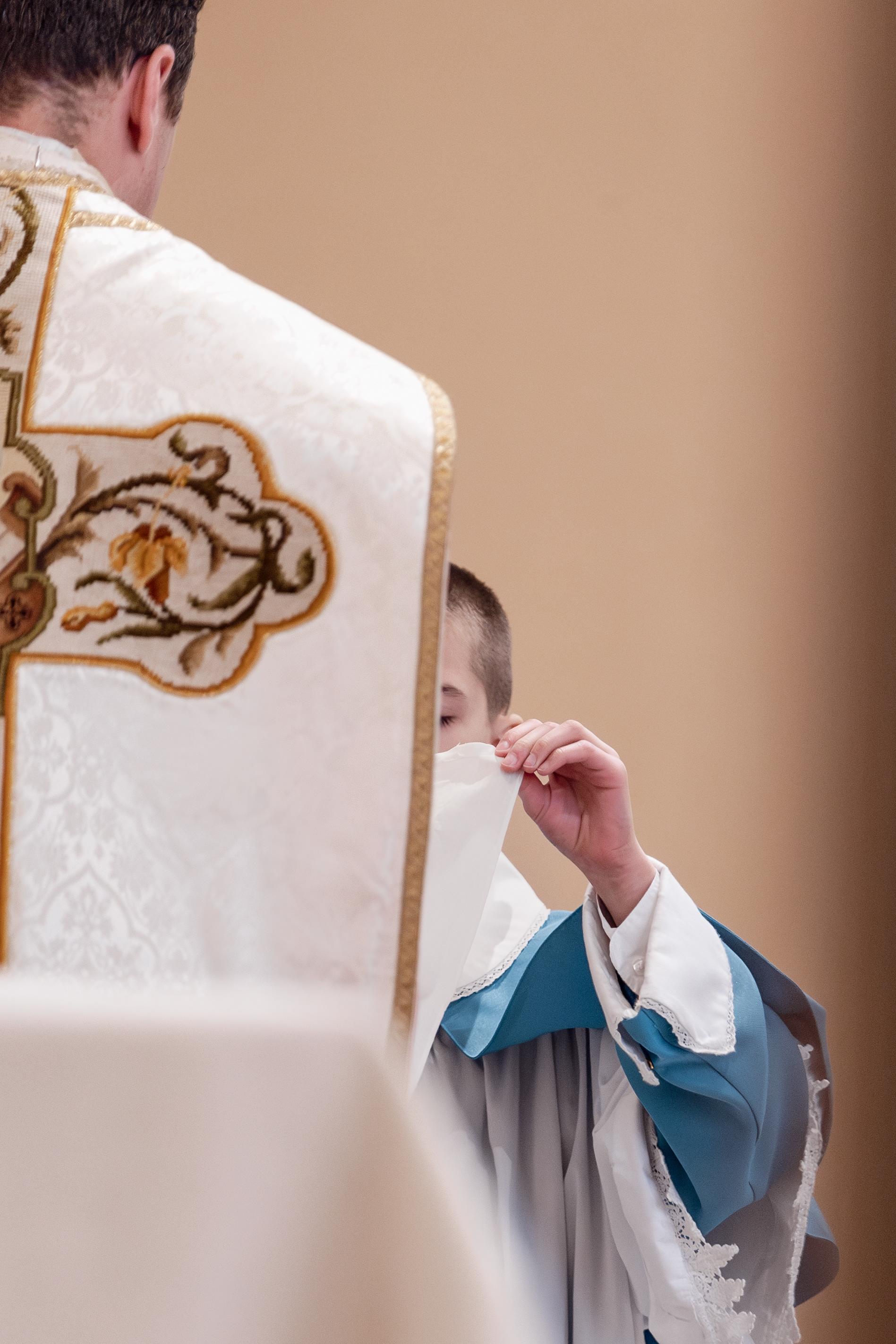
Returning to the Epistle side, he washes and dries his fingers as he recites Psalm 26 (DR 25):6-12, concluding with the Gloria Patri. This is called the Lavábo.
"Lavábo inter innocéntes manus meas: et circúmdabo altáre tuum, Dómine..."
(I will wash my hands among the innocent: and will encompass Your altar, O Lord...)
Psalm 26 (DR 25):6
(I will wash my hands among the innocent: and will encompass Your altar, O Lord...)
Psalm 26 (DR 25):6
He goes to the center of the altar and bows deeply, his hands on the altar.
Receive, O Holy Trinity, this oblation we make to You in remembrance of the Passion, Resurrection, and Ascension of Our Lord Jesus Christ, and in honor of blessed Mary ever Virgin, of blessed John the Baptist, the holy Apostles Peter and Paul, of these [names of the martyrs whose relics are in the altar stone] and of all the saints, that it may avail to their honor and our salvation: and that they may vouchsafe to intercede for us in heaven, whose memory we now keep on earth. Through the same Christ Our Lord. Amen.
He kisses the altar and slowly makes a full turn, extending his hands when he faces the people and says aloud, "Oráte, frátres" (Pray, brethren)
Completing his turn, he continues quietly:
"ut meam ac vestrum sacrifícium acceptábile fiat apud Deum Patrem omnipoténtem."
(that my sacrifice and yours may be acceptable to God the almighty Father.)
(that my sacrifice and yours may be acceptable to God the almighty Father.)
The servers respond, "Suscípiat Dóminus sacrifícium de manibus tuis, et laudem, et glóriam nominis sui, ad utilitátem quoque nostram, totiúsque Ecclésiae suae sanctae."
(May the Lord accept this sacrifice at your hands for the praise and glory of His Name, for our good, and for the good of all His holy Church.)
(May the Lord accept this sacrifice at your hands for the praise and glory of His Name, for our good, and for the good of all His holy Church.)
The priest says, "Amen."
He recites the next Proper, called the Secret. It is a prayer containing petitions that refer specifically to the bread and wine that have just been offered. As its name suggests, this is the only one of the Propers that is not recited aloud. Facing the altar, he begins the Preface dialogue.
P: "Dóminus vobíscum." (The Lord be with you.)
S: "Et cum spíritu tuo." (And with your spirit.)
S: "Et cum spíritu tuo." (And with your spirit.)
*Liturgy Note: Unlike the other appearances of the Dóminus vobíscum, the priest does not turn to face the people here. When he turns to the people, extends his hands, and says, "Oráte fratres" - the only time he makes a full turn instead of turning back in the same direction - he "gathers the people up and take them with him" as he completes his turn. We are thus with him at the altar during this portion of the Mass and he need not turn to face us while addressing us.
He raises his hands:
P: "Sursum corda." (Lift up your hearts.)
S: "Habémus a Dómino." (We lift them up to the Lord.)
S: "Habémus a Dómino." (We lift them up to the Lord.)
Bringing his hands down and in:
P: "Gratias agámus..." (Let us give thanks...)
P: "Gratias agámus..." (Let us give thanks...)
He bows:
P: "...Dómino Deo nostro." (...to the Lord Our God.)
S: "Dignum et justum est." (It is right and just.)
S: "Dignum et justum est." (It is right and just.)
He opens his hands again and holds this position (the "orans" posture) until the end of the Preface. "Vere dignum et justum est, aequum et salutáre, nos tibi semper et ubíque gratis ágere..." (It is truly right and just, our duty and our salvation, always and everywhere to give You thanks...)
There are 15 different Prefaces and the feast of the day determines which one is used. Sundays not within a particular Liturgical Season use the Preface of the Most Holy Trinity. There are also Prefaces for Our Lady, the Apostles, of various feasts of Our Lord, for the Dead, and for Lent and Advent, among others.
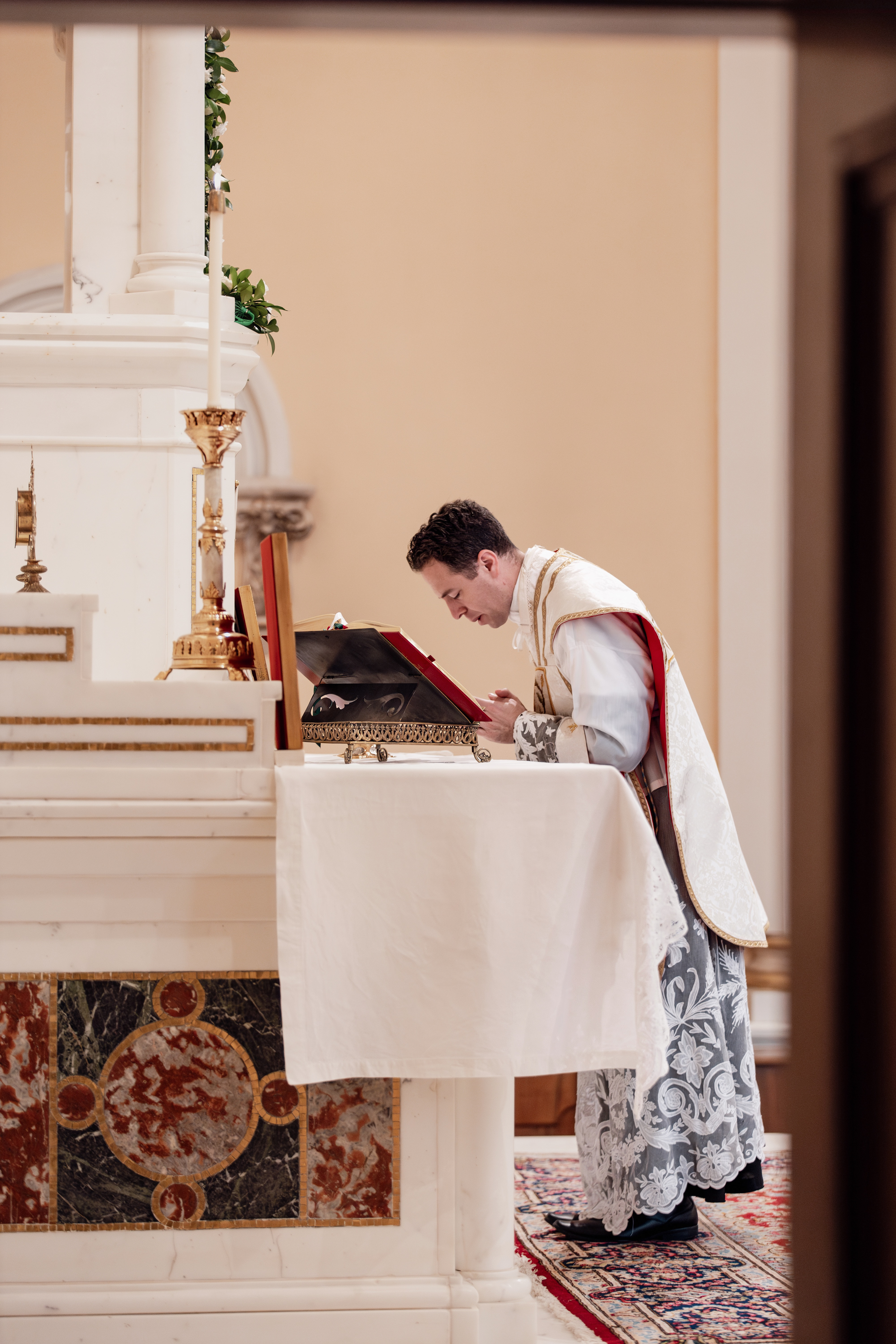
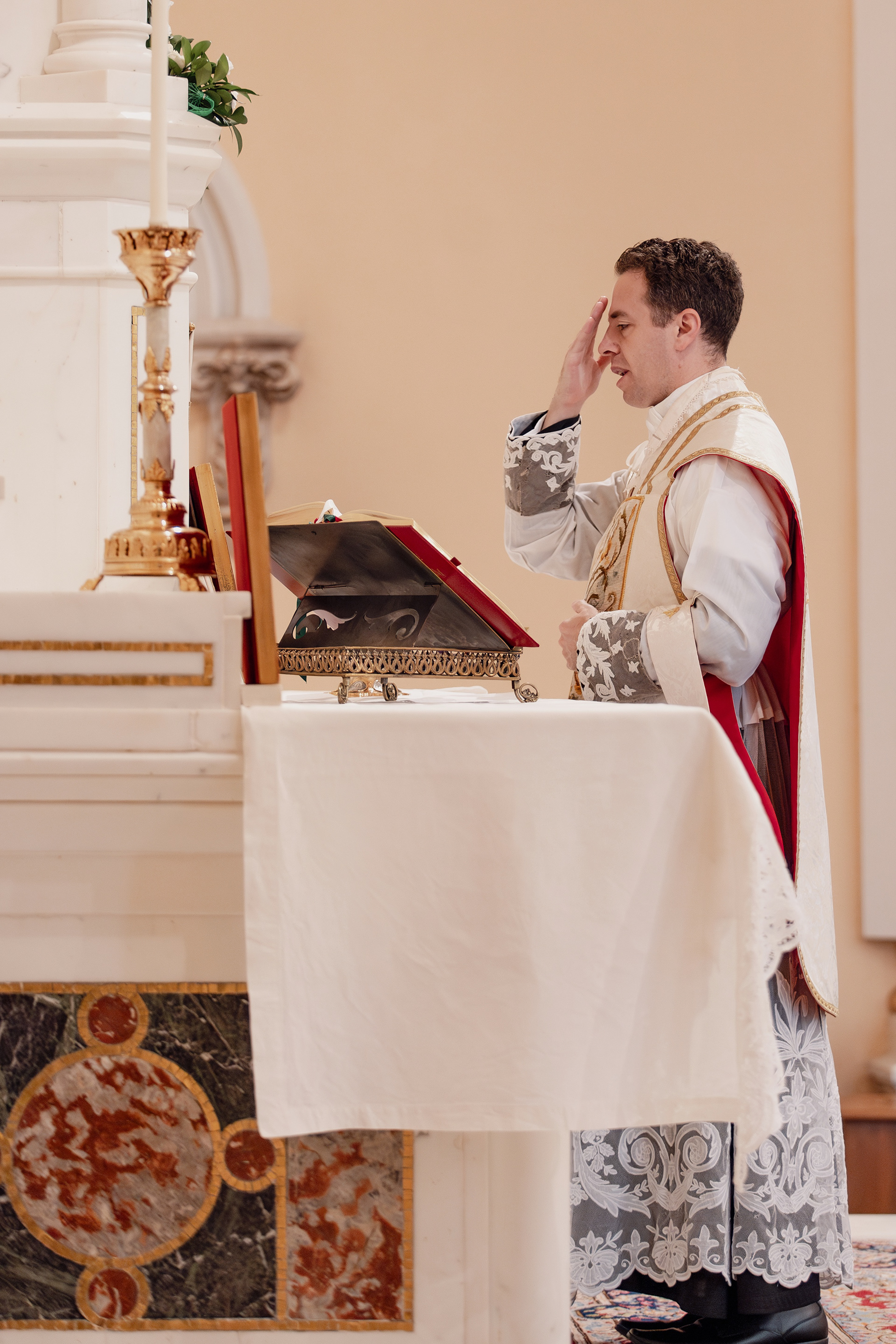
The Preface goes directly into the Sanctus, the third Mass Ordinary. At Low Mass (and at some parishes at High Mass as well), bells are rung at each repetition of the word "Sanctus."
The priest folds his hands, bows, and says,
"Sanctus, sanctus, sanctus, Dóminus Deus Sábaoth. Pleni sunt caeli et terra glória tua. Hosánna in excélsis. [He stands upright and makes the Sign of the Cross.] Benedíctus qui venit in nomíne Dómini. Hosánna in excélsis."
(Holy, holy, holy, Lord God of hosts. Heaven and earth are full of Your glory. Hosanna in the highest. + Blessed is He Who comes in the Name of the Lord. Hosanna in the highest.)
(Holy, holy, holy, Lord God of hosts. Heaven and earth are full of Your glory. Hosanna in the highest. + Blessed is He Who comes in the Name of the Lord. Hosanna in the highest.)
CANON MISSAE
THE ROMAN CANON
*Photography Note: The placement of the Missal obscures some of this portion of the Mass. Shooting from the other side was not an option as the only way to access the sacristy on the Epistle side is to walk straight through the sanctuary. I like the sense of holy mystery that this angle preserves while still showing much of what isn't seen from the nave.
"From all time, the Canon has been recited silently. The congregation present can contribute nothing to the sacrifice itself; the people are present before a mystery which it is for the consecrated priest alone to accomplish. The priest has entered alone into the Holy of Holies to pray and offer sacrifice for the whole Church."
1962 Daily Roman Missal, Angelus Press
1962 Daily Roman Missal, Angelus Press
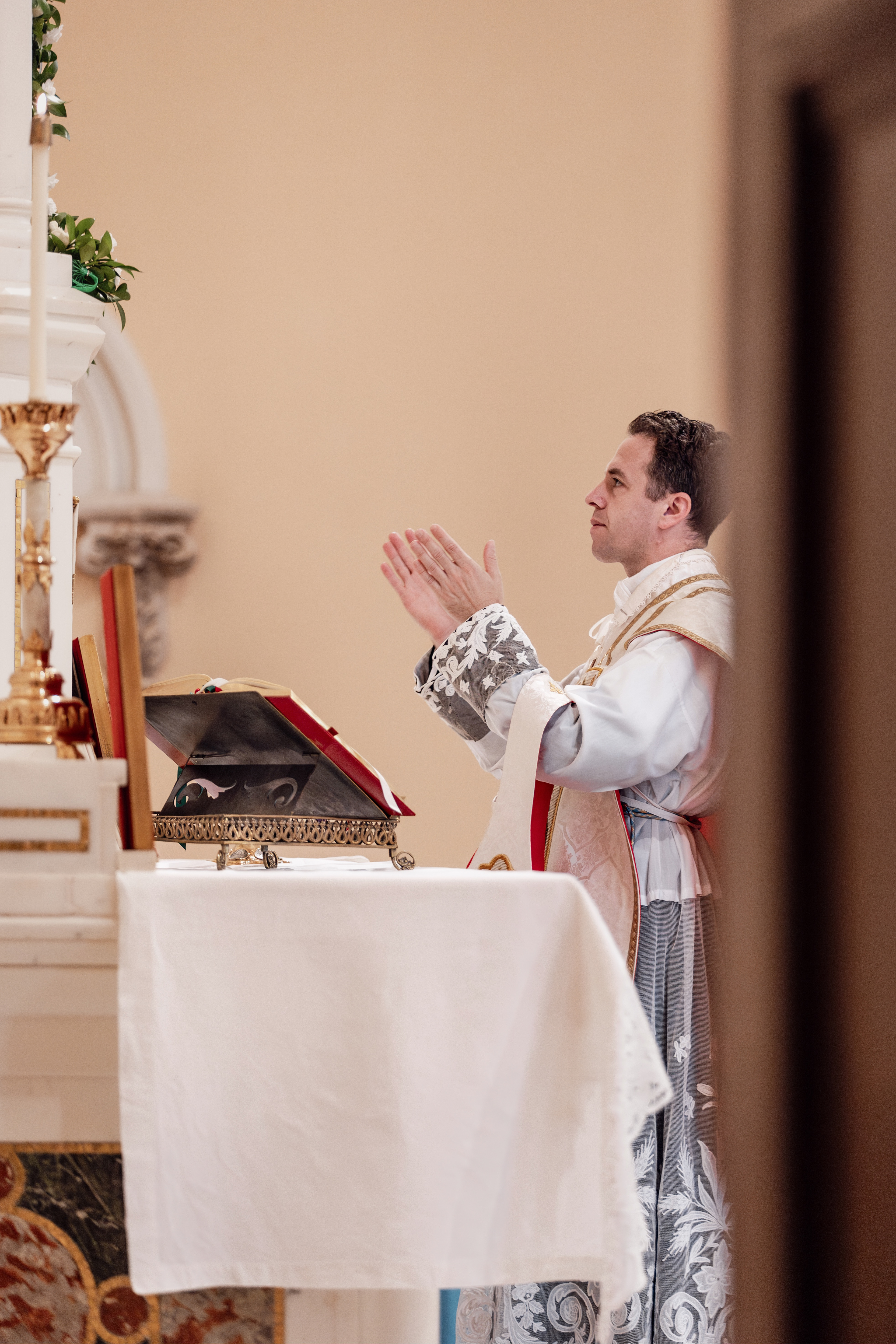
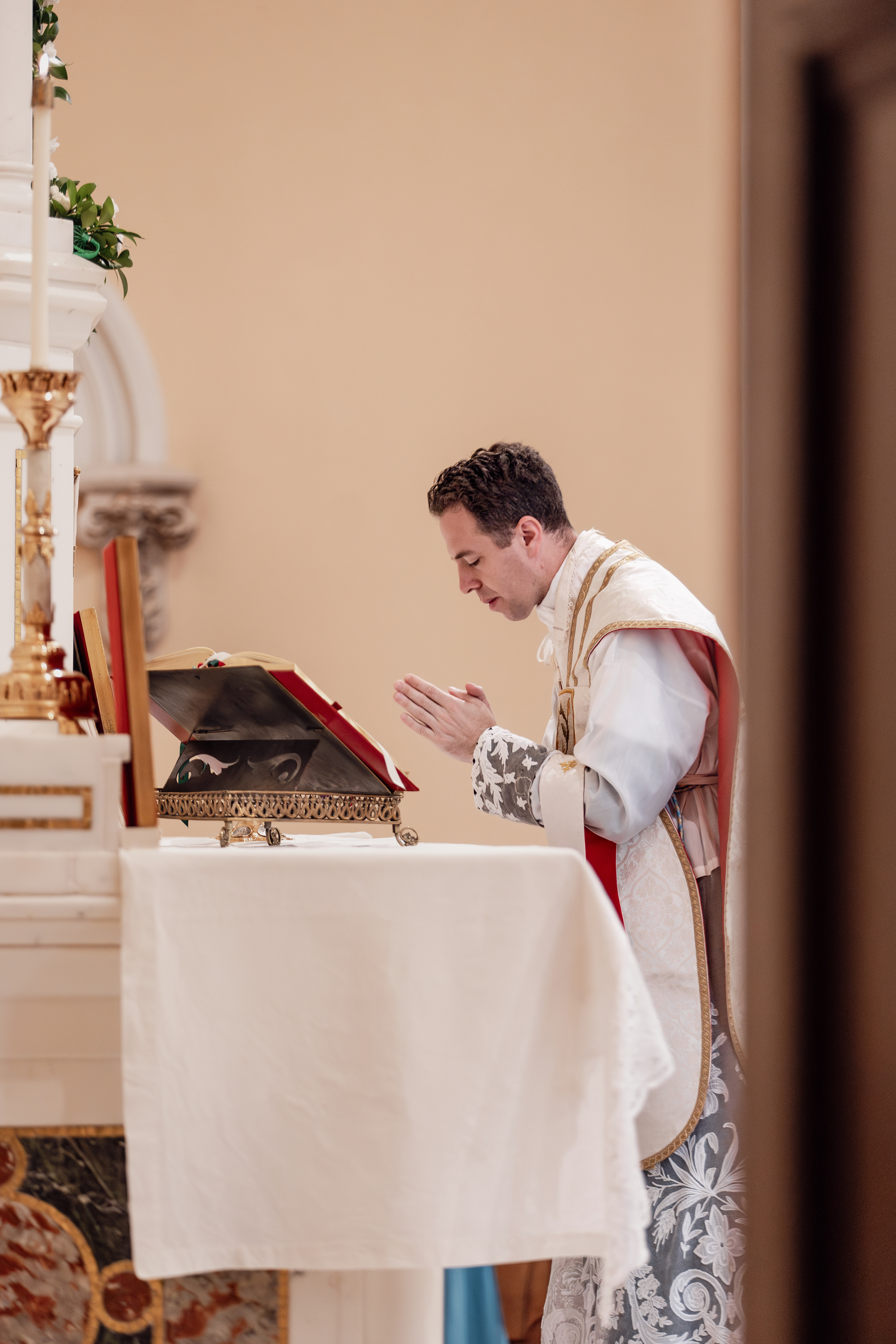
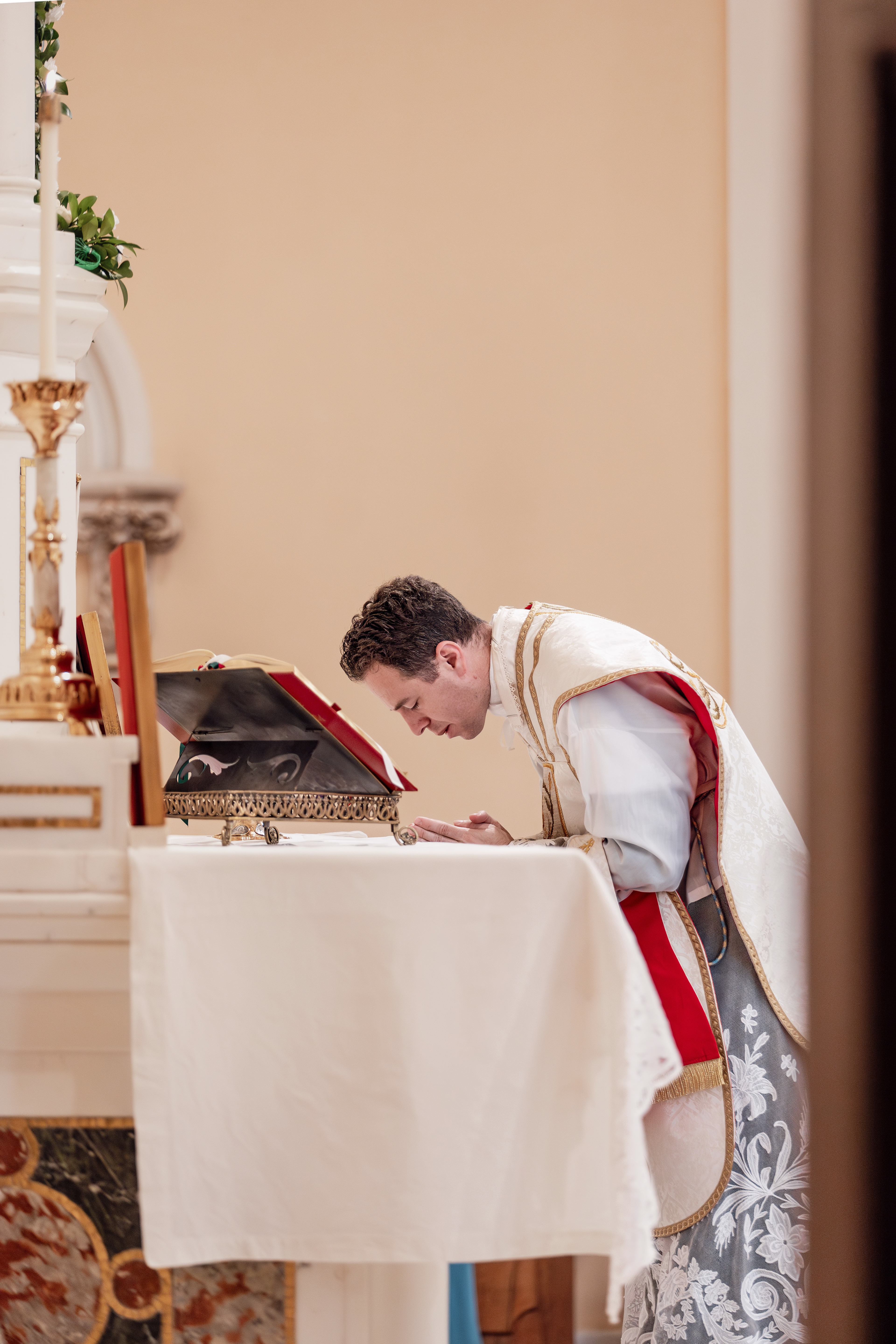
Making the priestly gesture, he bows deeply and places his hands on the altar, praying quietly:
To You, therefore, most merciful Father, we make humble prayer and petition through Jesus Christ, Your Son, Our Lord,
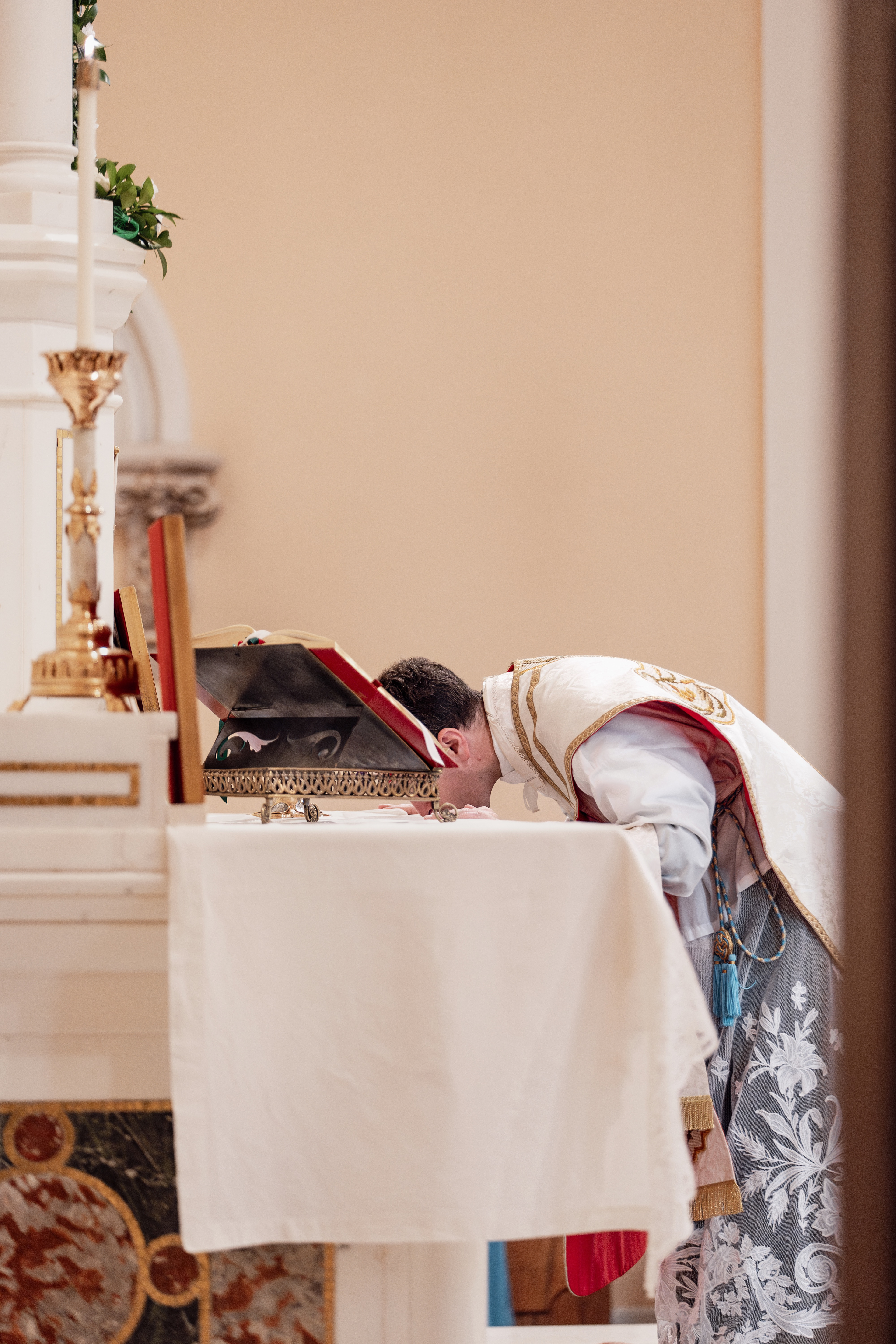
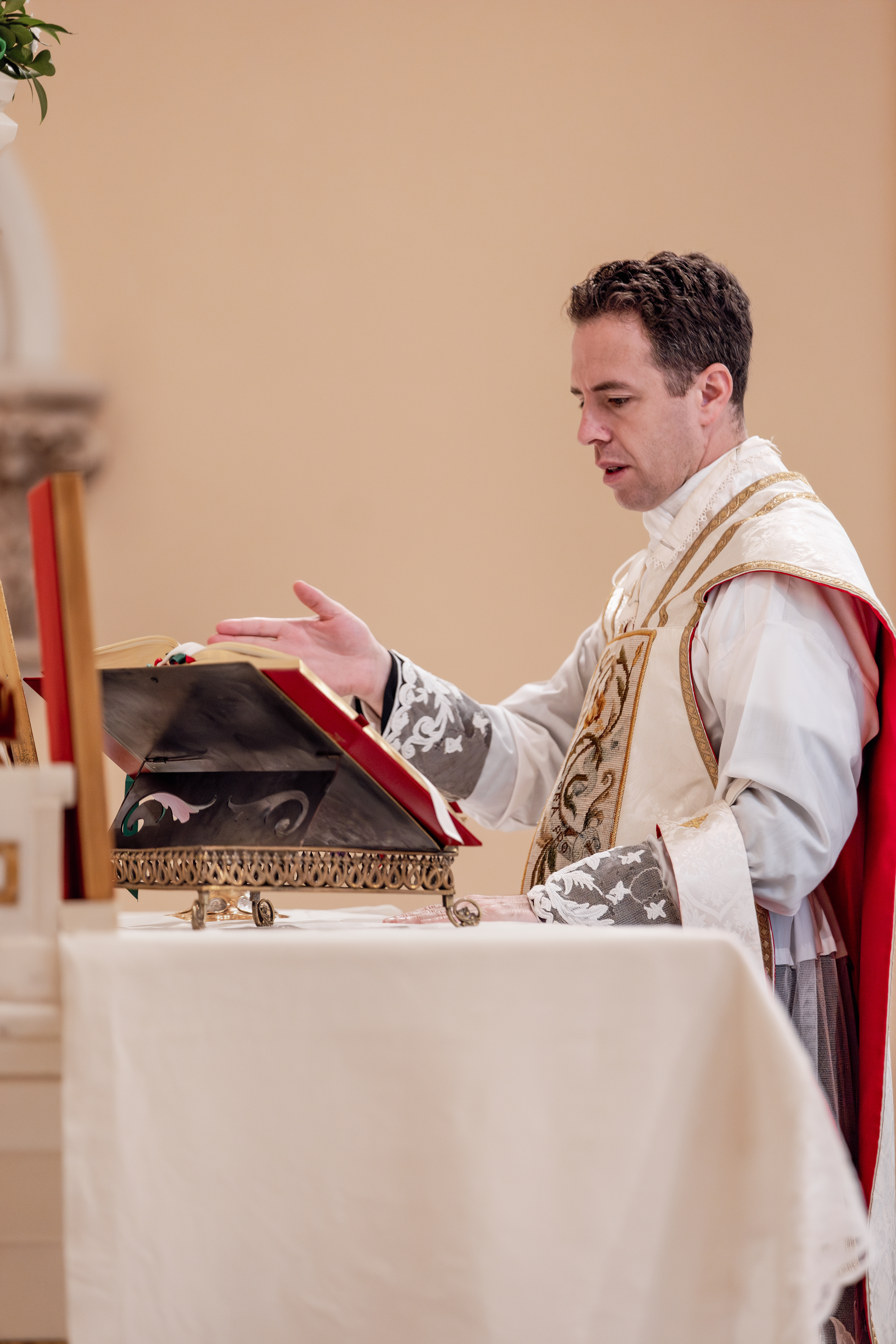
He kisses the altar, stands upright and joins his hands, and signs the offering with the Cross:
that You would accept and bless these + gifts, these + offerings, these + holy and unblemished sacrifices,
He opens his hands:
which we offer You firstly for Your holy catholic Church. Be pleased to grant her peace, to guard, unite and govern her throughout the whole world, together with Your servant [Francis] our Pope and [James] our Bishop, and all those who, holding to the truth, hand on the catholic and apostolic faith.
Remember, Lord, Your servants.
He folds his hands and calls to mind those for whom he intends to pray. After a few moments, he continues:
and all gathered here, whose faith and devotion are known to You. For them, we offer You this sacrifice of praise or they offer it for themselves and all who are dear to them: for the redemption of their souls, in hope of health and well-being, and paying their homage to You, the eternal God, living and true.
In communion with those whose memory we venerate, especially the glorious ever-Virgin Mary, Mother of our God and Lord, Jesus Christ, of blessed Joseph, her spouse, Your blessed Apostles and Martyrs, Peter and Paul, Andrew, James, John, Thomas, James, Philip, Bartholomew, Matthew, Simon and Jude; Linus, Cletus, Clement, Sixtus, Cornelius, Cyprian, Lawrence, Chrysogonus, John and Paul, Cosmas and Damian and all Your Saints; we ask that through their merits and prayers, in all things we may be defended by Your protecting help.
Through Christ our Lord. Amen.
Through Christ our Lord. Amen.
*Liturgy Note: There are several variations of this second prayer, called the Communicántes, which are proper to certain solemnities and seasons - Christmas, the Epiphany, Easter, the Ascension, and Pentecost.
The bells ring as he spreads his hands over the offering:
Therefore, Lord, we pray: graciously accept this oblation of our service, that of Your whole family; order our days in Your peace, and command that we be delivered from eternal damnation and counted among the flock of those You have chosen.
*Liturgy Note: This prayer, called the Hanc Igitur (this therefore) has a variation proper to Easter and Pentecost.
He joins his hands:
Through Christ Our Lord. Amen.
Be pleased, O God, we pray,
to bless +, acknowledge +, and approve + this offering in every respect; make it spiritual and acceptable, so that it may become for us the Body + and Blood + of Your most beloved Son, our Lord Jesus Christ.
He signs the oblation thrice and makes the Sign of the Cross once each over the host and the chalice. These five Signs represent the five Wounds of Christ.
*Liturgy Note: The role of the priest as "alter Christus" (another Christ) and "in Persona Christi" (in the Person of Christ) is emphasized especially strongly in the rubrics during the consecration as he imitates the actions of Christ while he describes them.
He takes the host in his hands:
On the day before He was to suffer, He took bread in His holy and venerable hands,
He looks up at the altar Crucifix:
and with eyes raised to heaven, to You, O God, His almighty Father,
Bowing his head:
giving You thanks,
He signs the host once more:
He said the blessing +, broke the bread, and gave it to His disciples, saying: take this, all of you, and eat it,
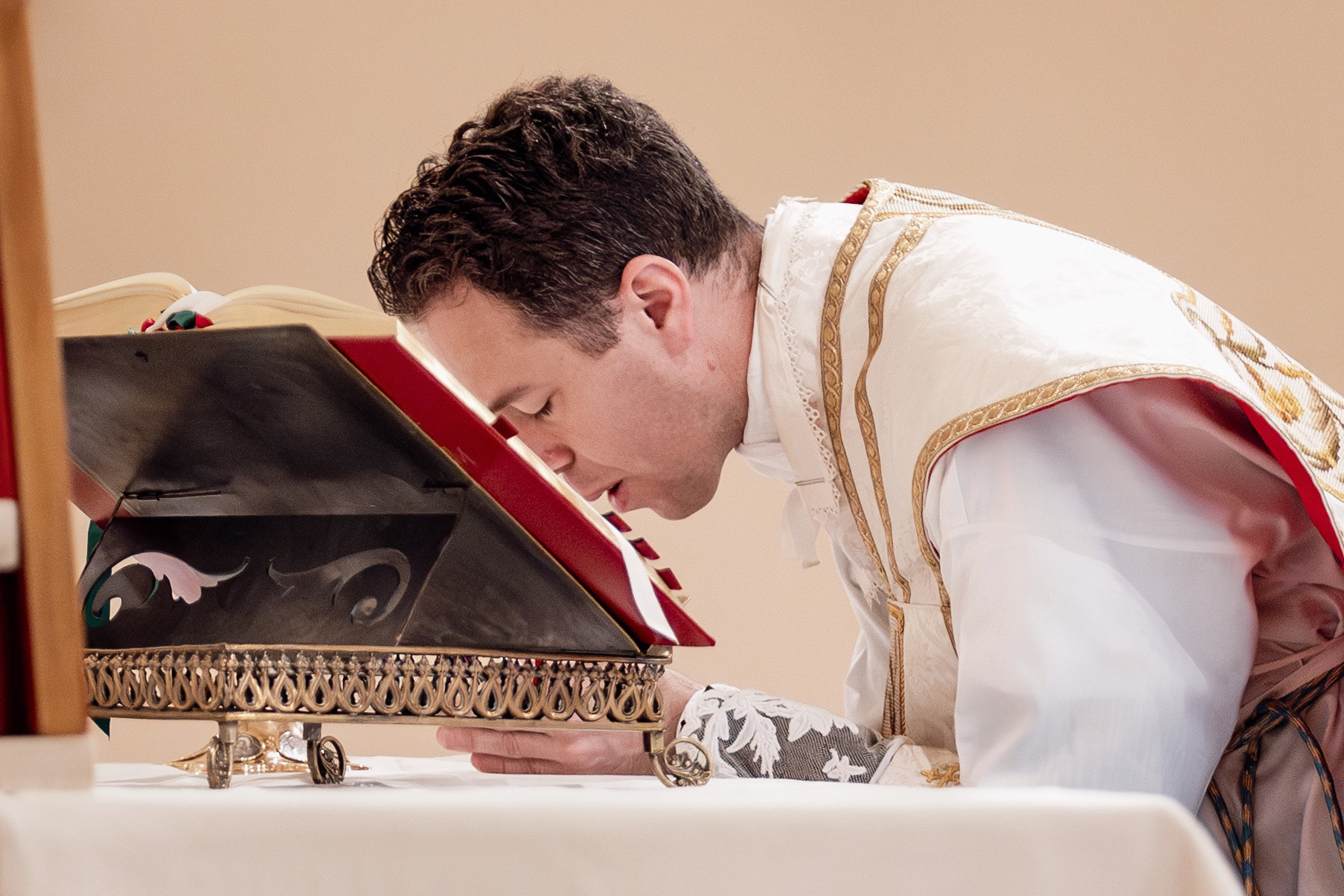
With the host between the thumb and forefinger of both hands, he bows low and quietly pronounces the words of consecration over it.
HOC EST ENIM CORPUS MEUM.
FOR THIS IS MY BODY.
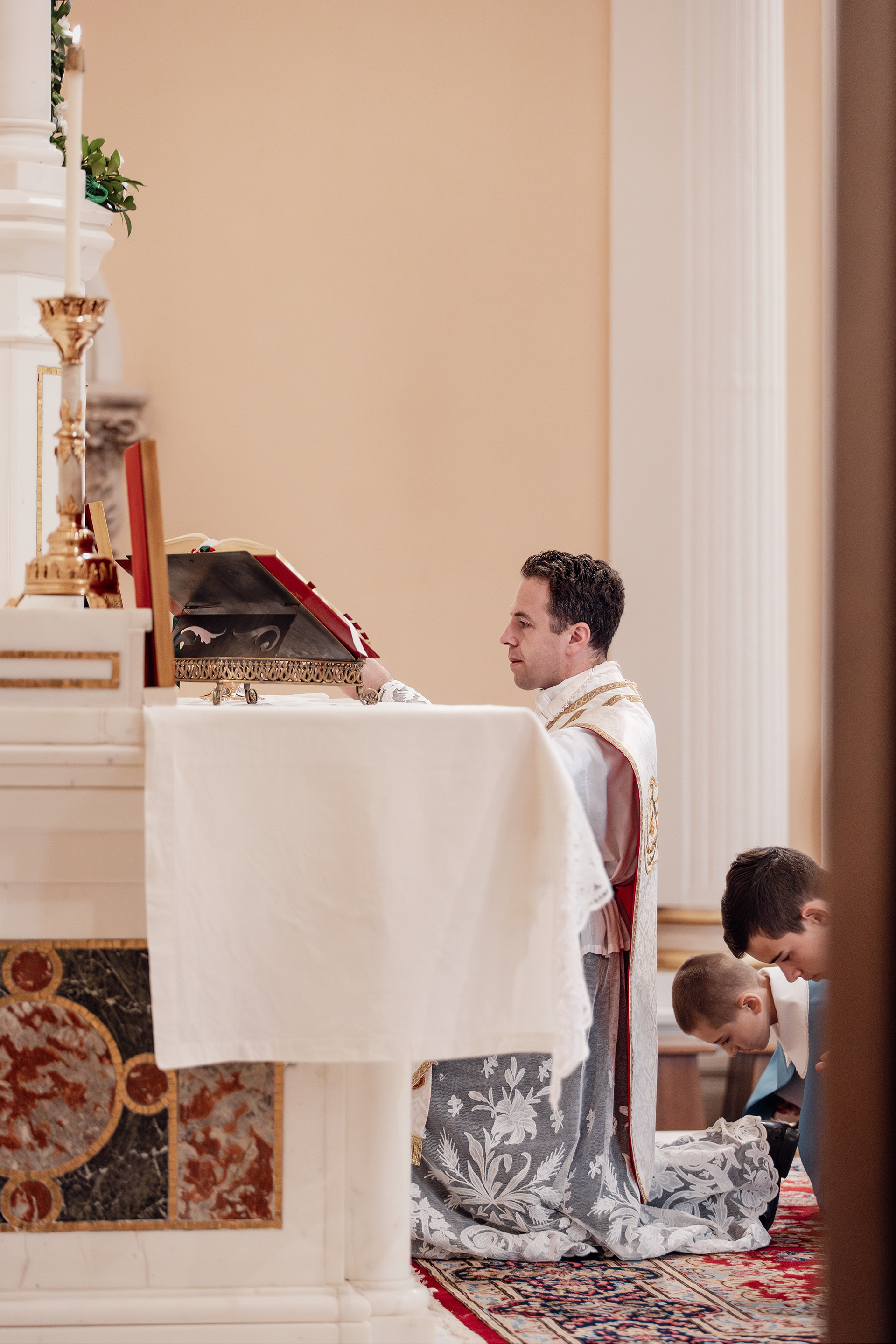
The bells ring as the priest genuflects with the consecrated Host in his hands.
*Liturgy Note: From this point on, the priest genuflects before and after each time he touches the Sacred Host.
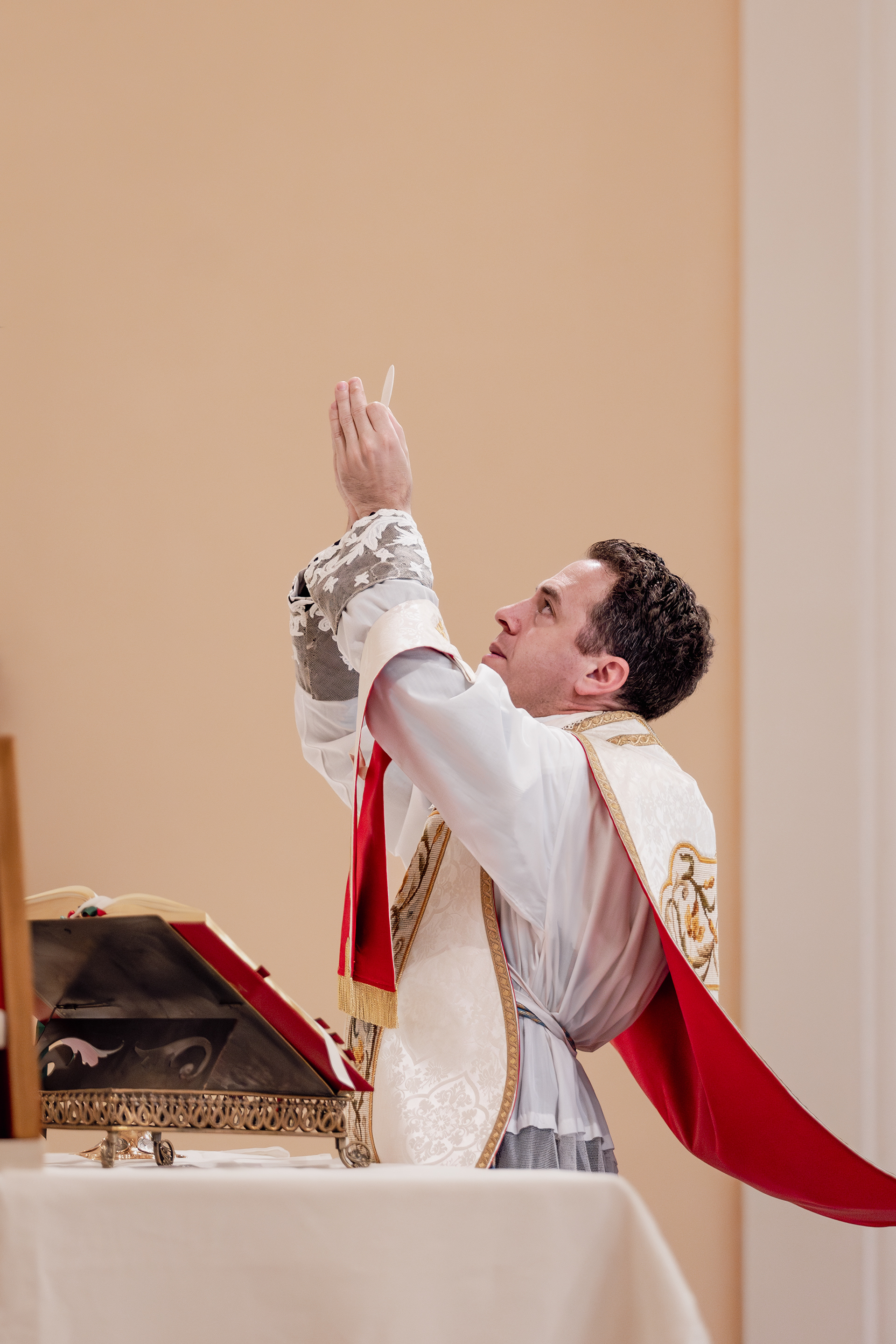
The bells ring again as the Host is elevated, and once more as the priest genuflects after placing Our Lord on the corporal.
*Liturgy Note: From now until after the ablutions following Communion, the thumb and forefinger are used only to touch the Host. The priest keeps these fingers together when performing any other actions so that no Particles of the Host may be lost. This is referred to as the "canonical digits." He will also not touch them - even when pressed together - to anything that is not consecrated and fit to come into contact with the Body of Our Lord.
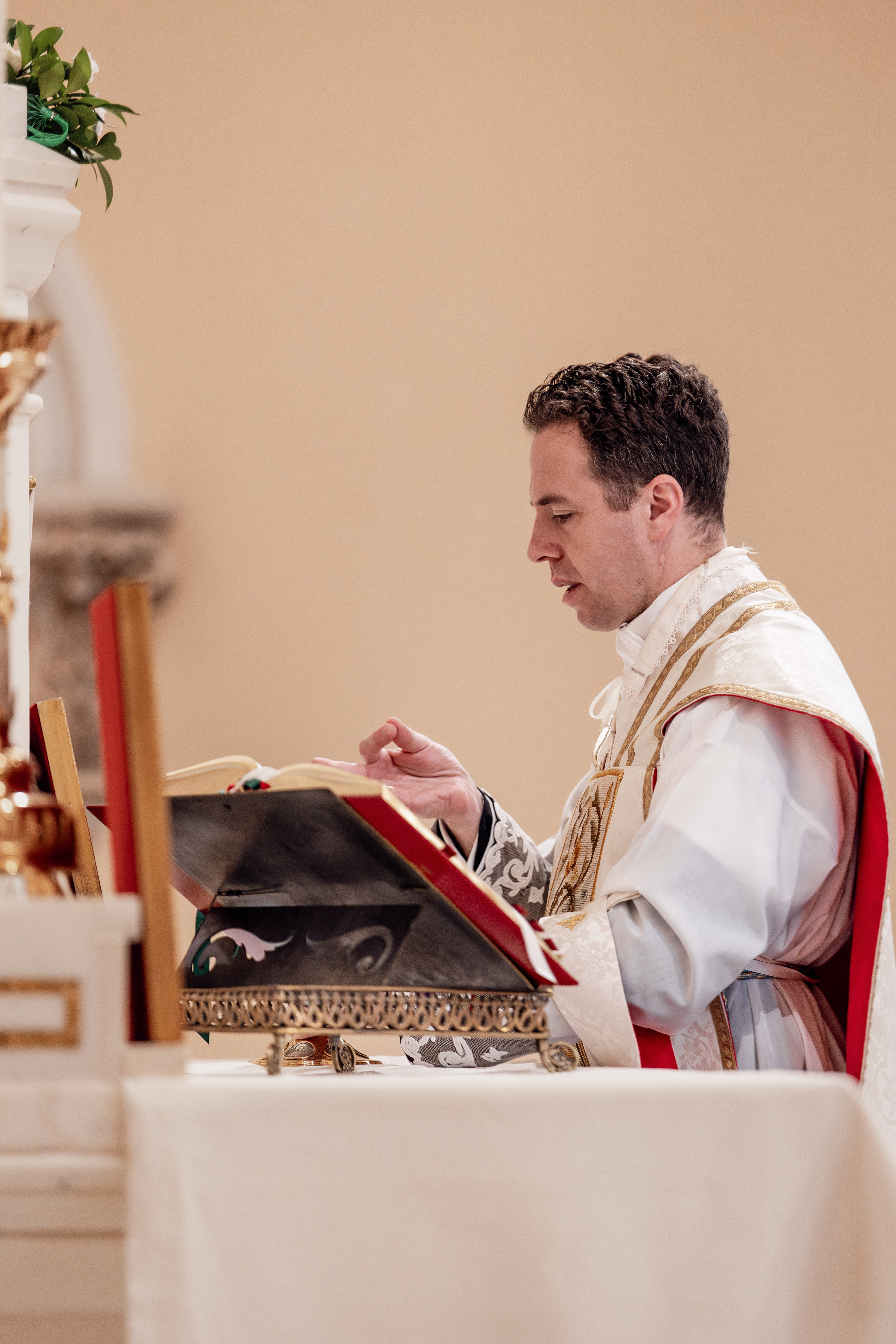
After uncovering the chalice:
In a similar way, when supper was ended, He took this precious chalice in His holy and venerable Hands, and once more giving You thanks, He said the blessing + and gave the chalice to His disciples, saying: take this, all of you, and drink it,
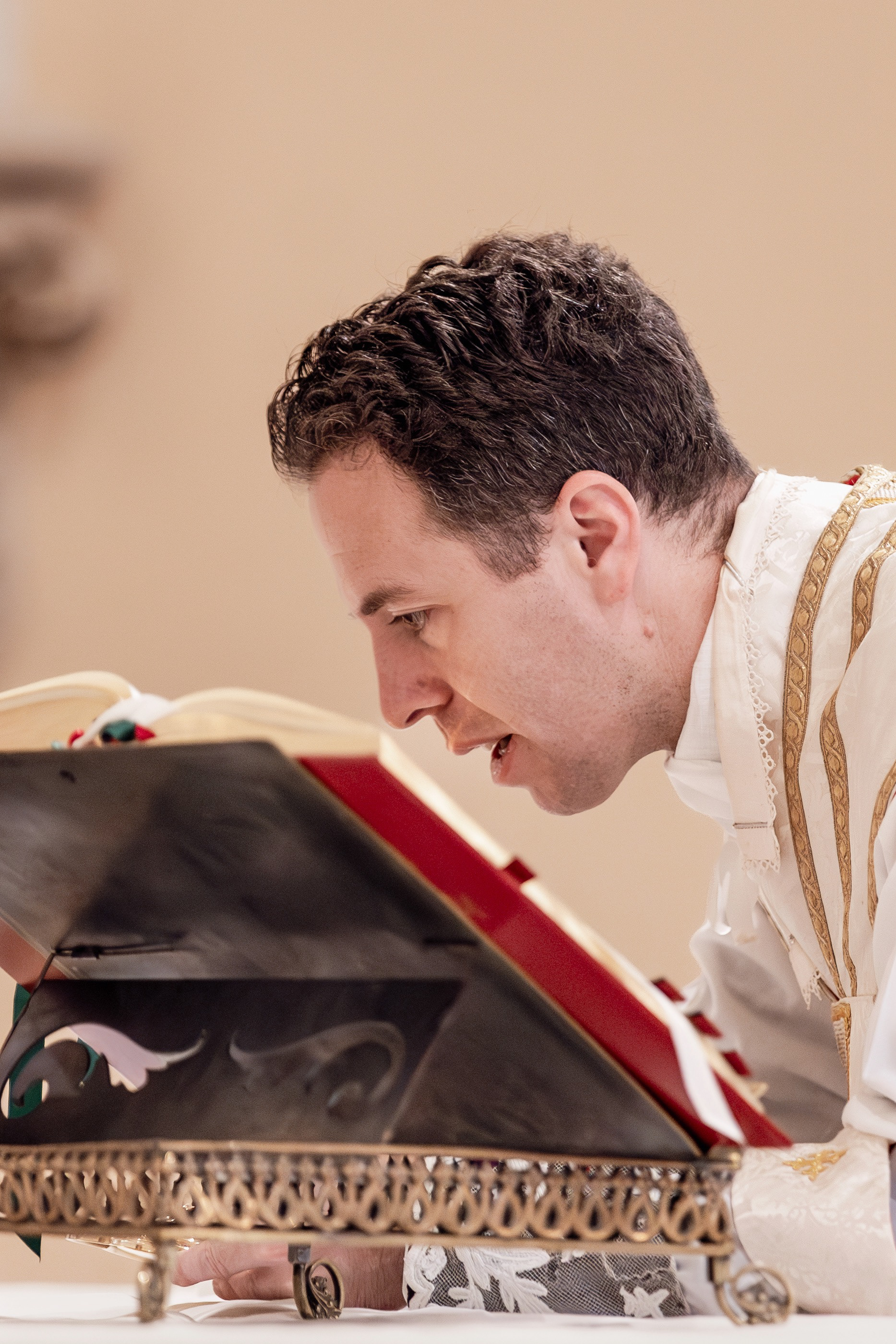
Raising the chalice slightly towards himself, he quietly says the words of consecration.
HIC EST ENIM CALIX SÁNGUINIS MEI,
NOVUM ET ÆTÉRNI TESTAMÉNTI:
MYSTÉRIUM FIDÉI:
QUO PRO VOBIS ET PRO MULTIS
EFFUNDÉTUR IN REMISSIÓNEM PECCATÓRUM.
NOVUM ET ÆTÉRNI TESTAMÉNTI:
MYSTÉRIUM FIDÉI:
QUO PRO VOBIS ET PRO MULTIS
EFFUNDÉTUR IN REMISSIÓNEM PECCATÓRUM.
FOR THIS IS THE CHALICE OF MY BLOOD,
OF THE NEW AND ETERNAL TESTAMENT:
THE MYSTERY OF FAITH:
WHICH SHALL BE SHED FOR YOU AND FOR MANY
UNTO THE REMISSION OF SINS.
OF THE NEW AND ETERNAL TESTAMENT:
THE MYSTERY OF FAITH:
WHICH SHALL BE SHED FOR YOU AND FOR MANY
UNTO THE REMISSION OF SINS.
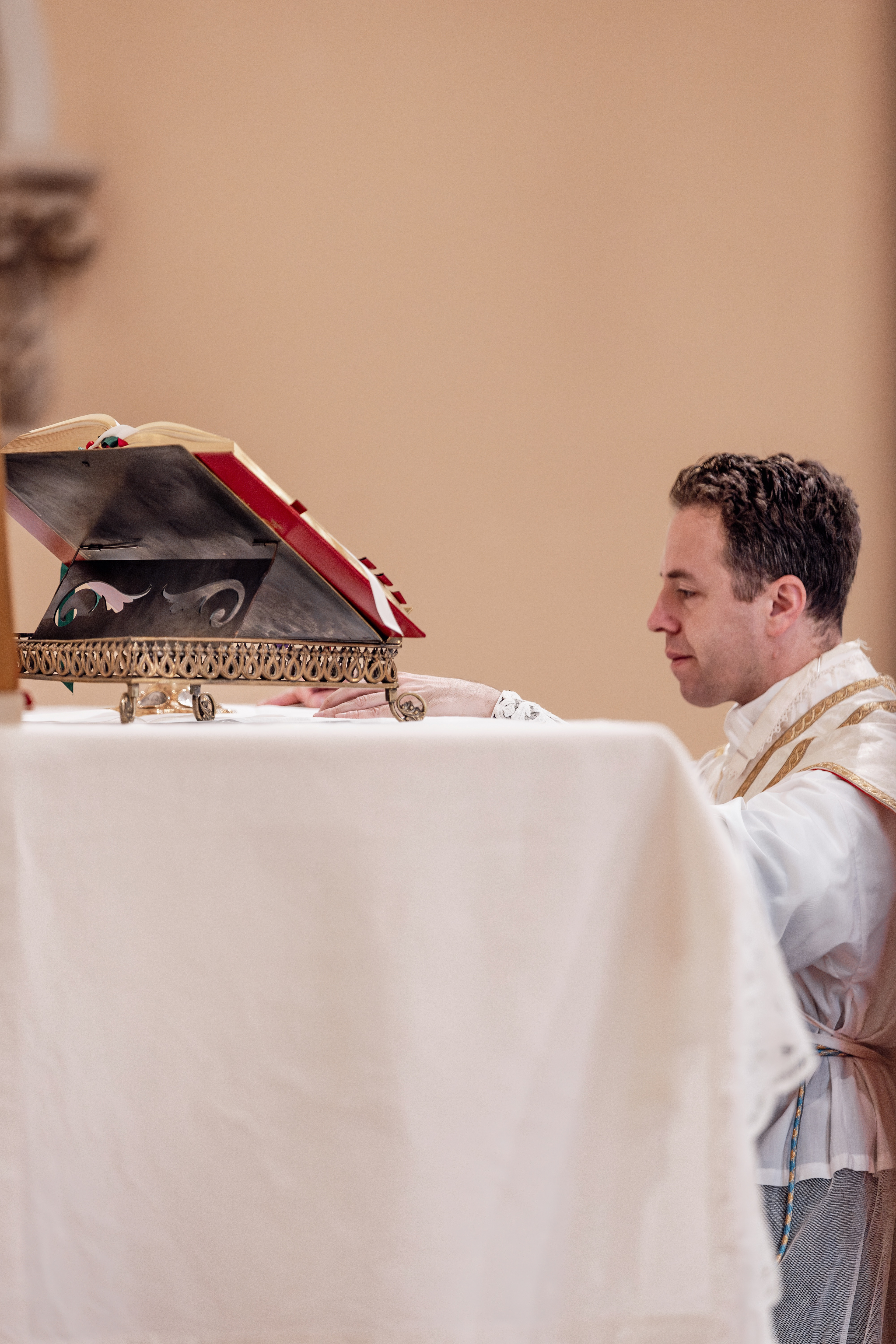
Placing the chalice on the corporal:
"Haec quotiescúmque fecéritis, in mei memóriam faciétis."
(As often as you shall do these things, you shall do them in remembrance of Me.)
(As often as you shall do these things, you shall do them in remembrance of Me.)
The bells ring as he genuflects.
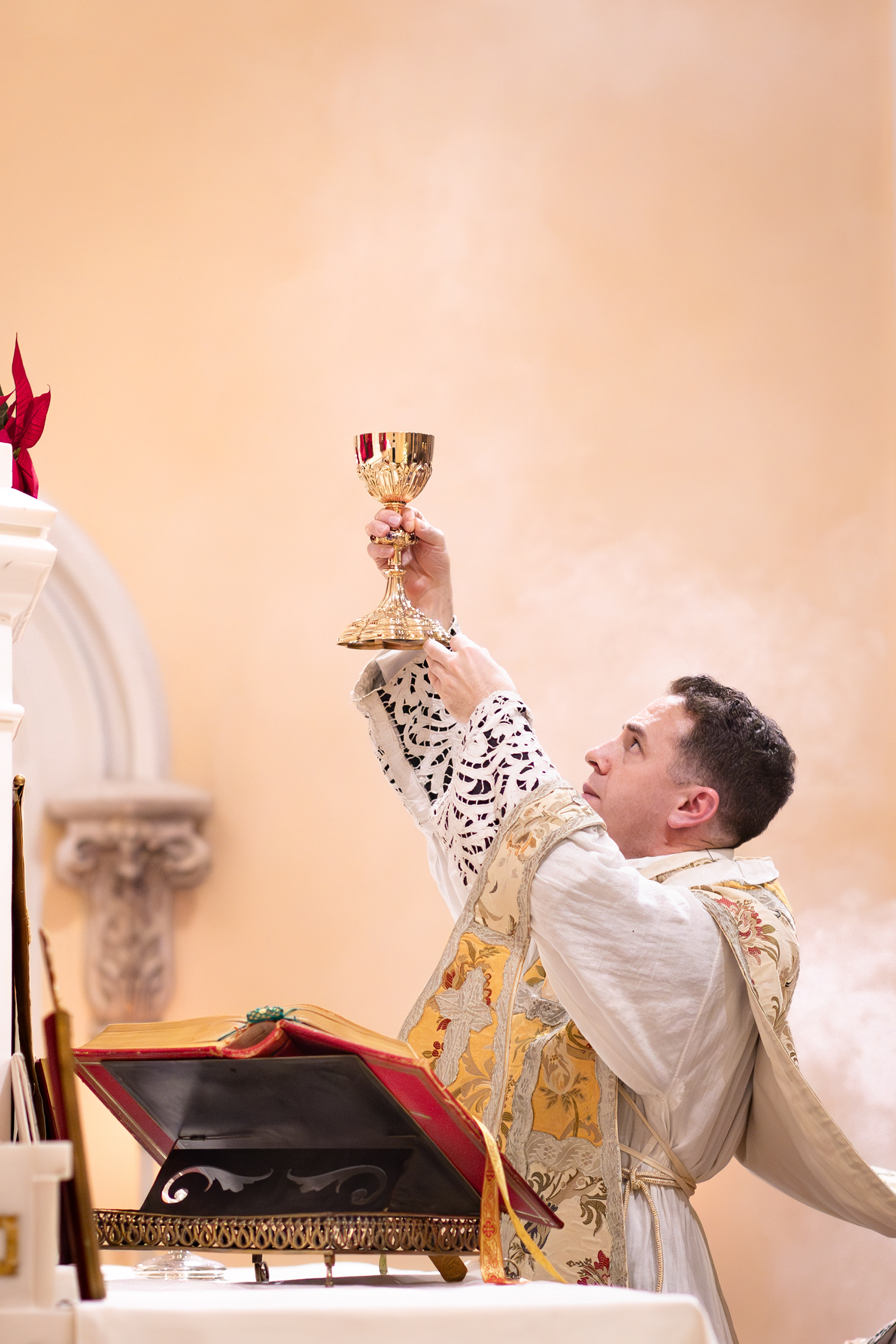
The bells ring as he elevates the Precious Blood. He replaces the chalice and genuflects, and the bells ring a third time.